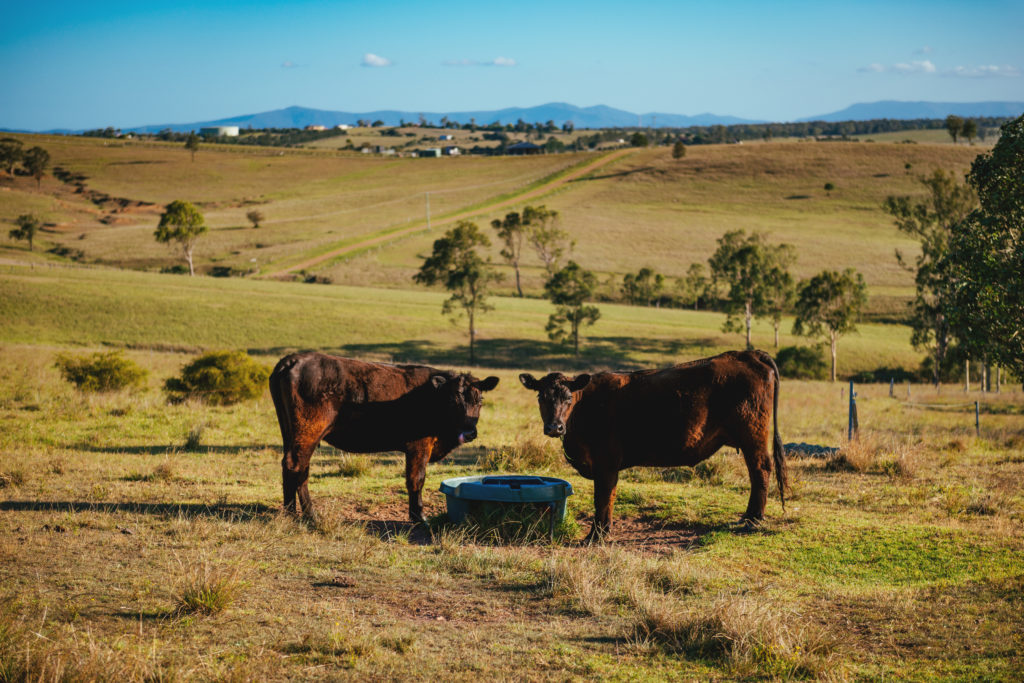
Bloat is generally associated with grazing pastures with a high legume content. While it has typically occurred during a four to six week window from late July to August, it is now becoming increasingly prevalent during a four to five month window from early May to early October with an estimated annual cost to the industry of $76.8m[1].
Pastures with a legume content over 50% are considered dangerous.Occasionally young grasses can also cause bloat if they contain large amounts of soluble protein.Early autumn breaks, mornings with dew on the pasture and overcast, windy days are also frequently associated with bloat events.
It is also important to note that heifers are said to be three times more likely to die from bloat than mature cows[2].
What is Bloat?
Cattle produce large volumes of gas during the normal process of rumination. This gas is either belched up or passes through the gastrointestinal tract. When cattle are grazing legumes and some young grasses, the foaming agents in these plants can trap the gas in small bubbles. As the gases build up, increasing pressure forces the rumen to protrude on the left side of the body and unless treated, can often result in death[3].
Signs of Bloat
- Not grazing
- Distended left abdomen
- Appear distressed – vocalise
- Strain to urinate and defecate
- Rapid breathing with mouth open and tongue protruding
Prevention
Unfortunately, there is no single fool-proof solution to control bloat other than eliminating access to higher risk pastures. There are however numerous methods that can be used to manage and prevent bloat, as outlined below.
Given the differences in the ease of implementation and palatability, it is not uncommon for producers to use more than one technique to minimise the risk of bloat.
Solutions
1. Molafos Liquid Supplements
Molafos Bloat plus Teric is a molasses and Teric blend developed to reduce bloat in a herd. It is palatable due to the molasses content and Teric oil (alcohol ethoxylate) provides the anti-foaming agent. It is convenient to implement by simply placing the product in open tubs or roller licker tubs in the paddock. The mixing technology used prevents the oil separating thereby allowing for the necessary and uniform intake of the oil component.
Molafos Bloat can be fed ad lib to cattle, however 1-2kg/head/day is recommended.
In addition to aiding bloat prevention, Molafos Bloat is a high-energy feed source, which can help cattle process high protein pastures available at this time of year.
2. Pasture Management
Silage, hay or more mature pasture can be used to help provide the bulk of feed cattle need so they do not need to consume as much of the higher risk pasture.Cows should only be allowed access to suspect pastures for short periods of time and should be monitored closely both during grazing and immediately after removal from pasture.
3. Monensin
Fermentation modifiers such as Sodium Monensin also work by preventing the production of foaming gases by changing the rumen microbial population. This however takes 10-14 to be effective so needs to be started early. Stock also need to ingest a minimum of 200mg/hd/day to prevent bloat. Once they stop consuming it the rumen reverts back within days and stock can again be susceptible to bloat[1]. It is important to note this solution is not suitable for those supplying beef into a pasture accredited scheme.
4. Spraying Pasture with oil
Spraying the entire days grazing with anti-bloat oil requires pastures to be strip grazed to ensure effective control. Oils only give 2-4 hours’ protection so therefore need to be applied and consumed during the grazing period. Cows require a dose of 85ml of oil per day.
5. Feeding in the bail
Detergent and oils have been added to dairy supplementary feeds with good results. Teric or bloat oil in powered form can be used by home mixers. Cows will only eat Teric voluntarily if mixed with molasses in equal proportions.
6. Flank Application
30-70ml of thick bloat oil can be applied to the flank of each cow with a brush. Cows will generally lick this from themselves during grazing.
7. Water Trough Application
Detergent can be added to troughs if it is the only source of water available to the cows. Teric is added at the rate of 40ml per 15L of drinking water.
8. Bloat Blocks
With this method, an adequate intake of the block by all cows is required for a suitable level of protection.
9. Drenching
Directly drenching with anti-foaming agents such as teric, paraffin or vegetable oil is practised successfully particularly in the dairy industry. Animals need to be kept moving after to ensure the drench is effectively mixed with the frothy rumen gases.
10. Capsules
While capsules have been used successfully in the past, they are not currently available with the finding that they are ineffective with Lucerne1 .
Summary
Ultimately prevention is better than cure.While developing the right pasture mix for your herd is a preferred solution, this can be difficult to achieve therefore providing an anti-bloat supplement early will help mitigate costly losses in a herd.
References
1. Prof Bruce Allworth, Charles Sturt University
2. Agriculture Victoria, Controlling Bloat in Dairy Cows
3. NSW DPI, Bloat in cattle and sheep




